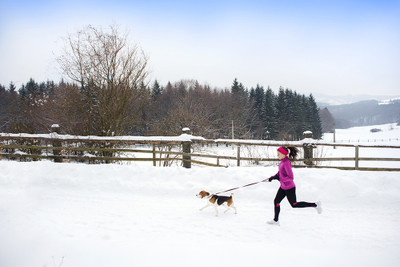Posted by Zena Conkey on Mar 02, 2020
When the nights become long, the days are dark, damp and short leaving you with far less to do than those long summer hikes with your hound what can you do to keep your dog happy?
With so many of us working through the daylight hours, the winter weather forbidding long walks and camping trips your dog’s energy can easily build up. So take a look at our favourite winter activities that will keep your dog busy through even the worst weather conditions.
Outdoor and Messy Activities - Cani-Cross
Cani-Cross is a winter treat if you are super fit and love running with your dog. The Cani-Cross season runs through the winter months because it’s better for dog’s to run during the cooler days than in the sunshine. Great for the sled dog breeds, yet suitable for every dog breed that loves to run, this is an activity that you and your dog can really get stuck into. All you need is a good harness, leash and belt to secure him around your waist and you can hit the hills. You can even run in the dark with a good head torch to light the way.
Indoor and Busy Activities - Search the Home

When it is just too nasty to go outside then you can do some indoor searching to keep your dog busy. Most dogs can search, using their superb sense of smell, if they are motivated enough here are some simple steps to teach your dog the basics of indoor search.
- Find a toy that your dog is motivated enough to search for, you can use something with food in if you need to.
- Play with the toy by rolling it away from him and sending him to fetch it. Add a command word that your dog can associate with looking for his toy.
- Start ‘dummy drops’ by having your dog sit and wait whist you pretend to hide his toy in a few different areas and only leave it in one of them. Touch all of the areas with your hands though because this will teach your dog to use his nose to locate his toy through the scent of disturbance that you create.
- When your dog can find the toy through dummy drops leave him to wait outside a room whilst you hide the toy, then send him in to fetch it.
- Gradually progress to more difficult hiding places, put the toy in drawers, up high, under furniture so that your dog has to work really hard with his nose to find it.
By watching your dog carefully you will soon be able to recognise his behaviour change as he locates a scent and his toy. His tail might wag faster, he might dig with his paws at the area where his toy is hidden or even bark towards it, or you, to try and get the toy to ‘pop out’ of its hiding place. The steps above are a very simplified version of the exact training steps used to prepare police, military and rescue dogs to search.
Search games are great because they use up both your dog’s physical and mental energy leaving him happy to settle afterwards.
